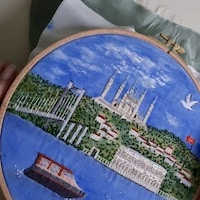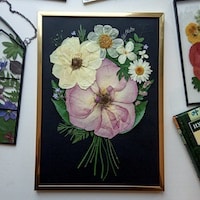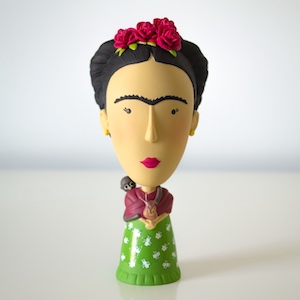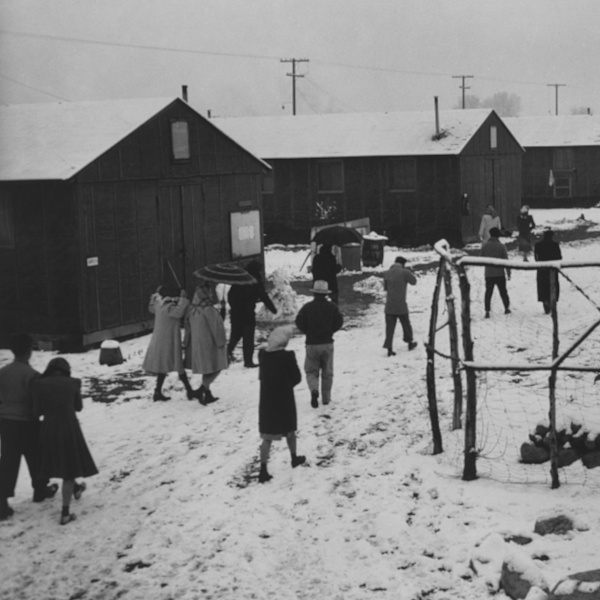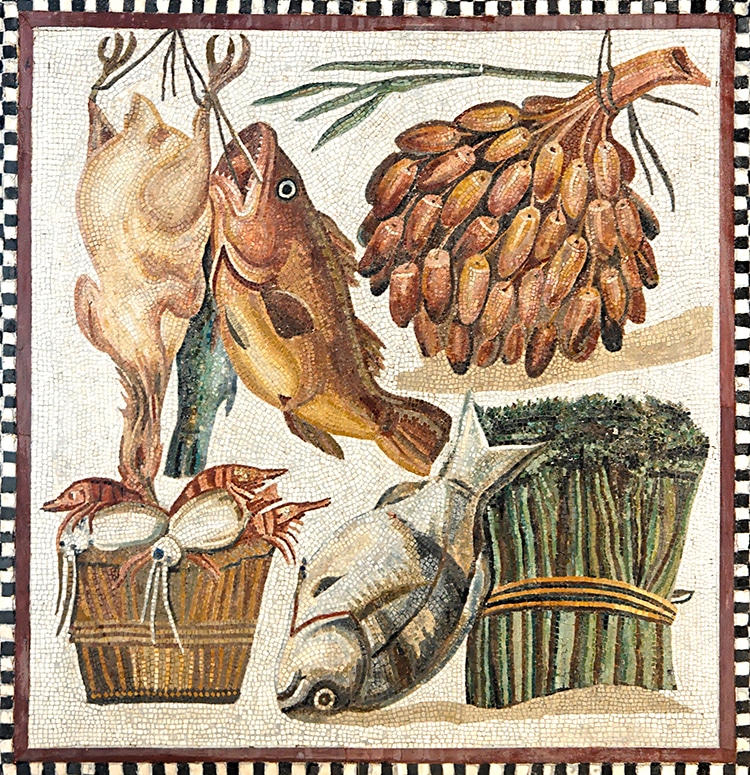
A 2nd century CE Roman mosaic showing a food still life, currently in the Vatican Museum. (Photo: Wikimedia Commons [Public domain])
Italian wine was drunk in Gaul while grain from Northern Africa supplied populations across the Mediterranean. The food and drink consumed throughout Roman lands also changed over time as new territories were gained and fashions changed. To ask “what did the Romans eat?” is to delve into a world of gastronomical diversity.
Across the empire, Ancient Roman food and drink were varied and diverse, but always interesting. Scroll down for a brief introduction to its culinary history.
Logistics of Dining in Ancient Rome
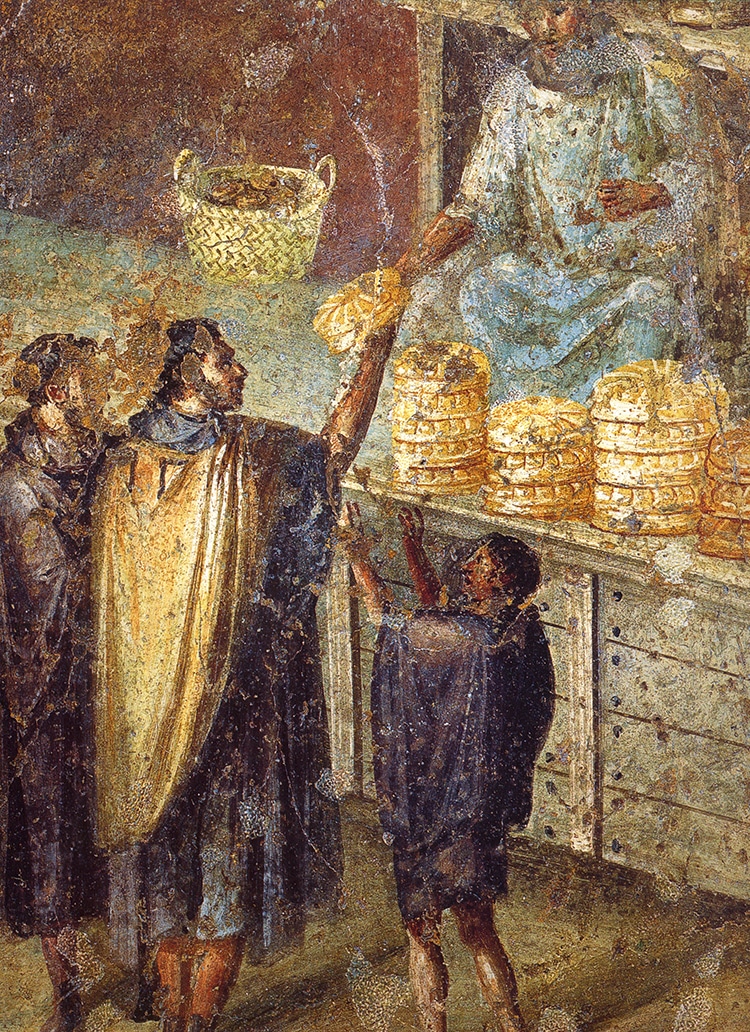
A painting from Roman Pompeii showing customers purchasing bread from a vendor at a market or street stall, held at Museo Archeologico Nazionale di Napoli. (Photo: Wikimedia Commons [Public domain])
To complement this knowledge, scholars of the classics find references to food and drink frequently occurring in the works of ancient philosophers, playwrights, and poets. Part of everyday life, these casual references to food can be illuminating. There are also Roman texts addressing food and drink, such as medicinal texts recommending concocted treatments. An ancient Latin cookbook known as Apicius was compiled during the first few centuries CE. The recipes listed include poultry, seafood, vegetables, and other ingredients. For adventurous cooks, the cookbook is free to explore in its entirety through Project Gutenberg.
Roman Mealtime

Roman 1st century BCE silver tableware from the Tivoli Hoard. (Photo: The Metropolitan Museum of Art [Public domain])
Customs of Dining
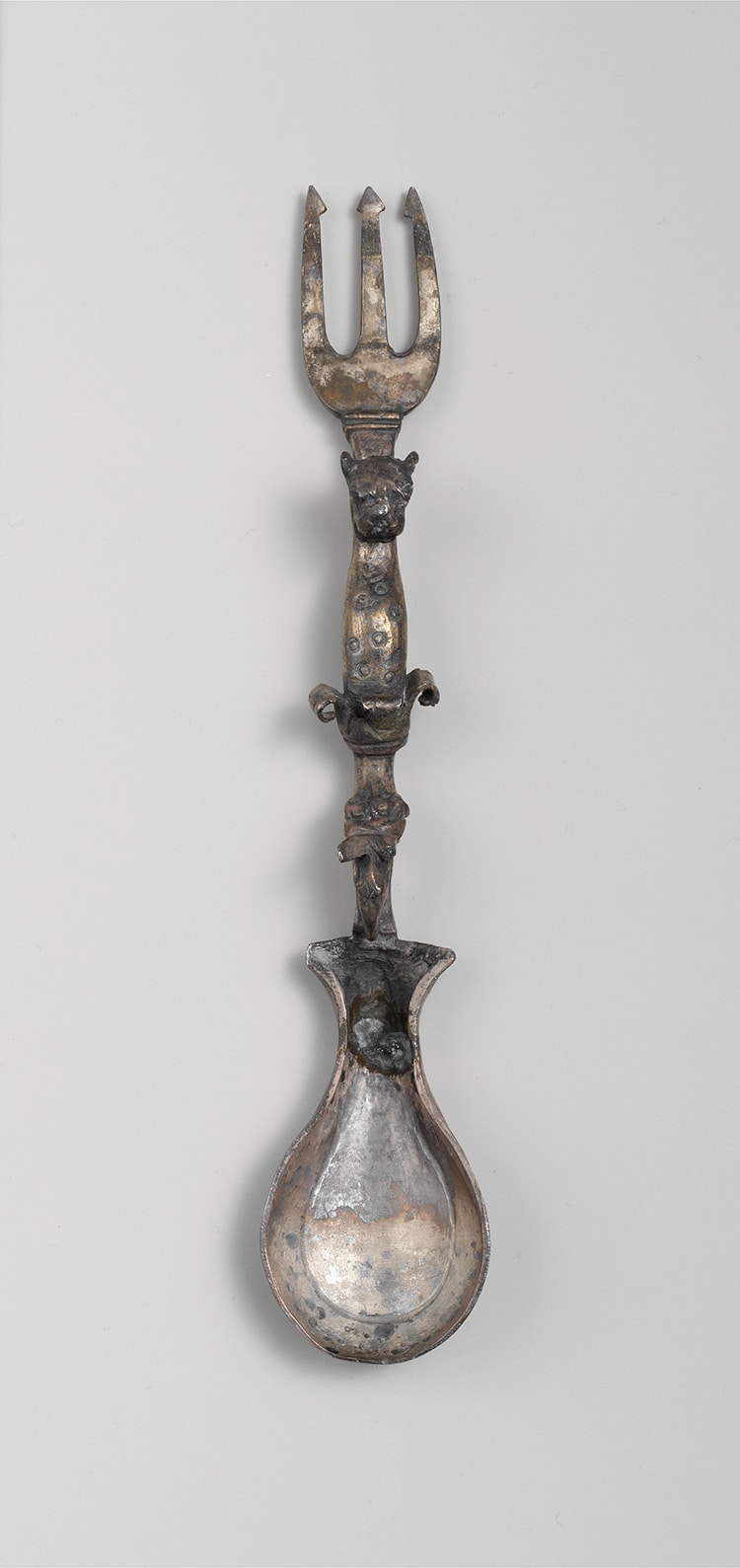
A sculpted silver spoon and fork combination utensil from the 3rd century CE. On the handle is a spotted panther (associated with the god Dionysus). (Photo: The Metropolitan Museum of Art [Public domain])
There were many locations to eat out in Ancient Roman cities. Taverns, inns, and market stalls produced ready-made meals to eat in or take out. However, dining in such establishments was typically a lower-class activity. Working people lacked the massive kitchens and chefs of the wealthier households. As sex workers could often be found in public food establishments, these places had a poor reputation in the opinion of more well-to-do Romans.
What food was eaten?
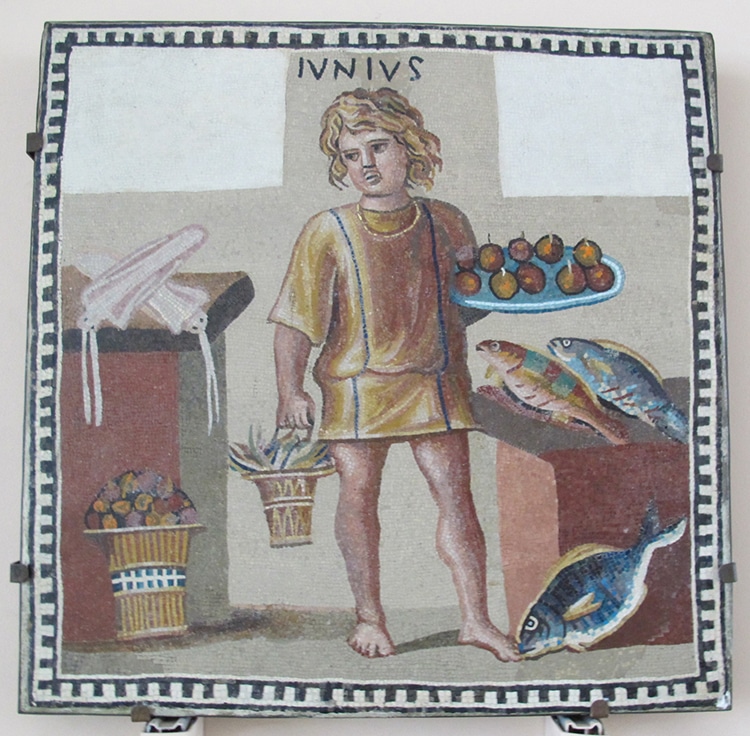
A 3rd century CE mosaic showing, fish, squid, fruit, and (it seems) crabs. (Photo: Sailko via Wikimedia Commons [CC BY-SA 3.0])
Meat, Fish, and Cheese

A still life fresco showing eggs and fowl from the House of Julia Felix in Pompeii. (Photo: Wikimedia Commons [Public domain])
The wealthiest Romans used the vast reaches of the empire to impress their guests with exotic or rare meats such as peacock, ostrich, and sow's udders. In the case of the last delicacy, such indulgence was even forbidden under sumptuary laws. Sumptuary laws regulate consumption to ensure social hierarchies or moral norms—meat dishes in Ancient Rome could be extravagant displays of wealth and class. Dormice were another delicacy outlawed by these laws—a fact probably surprising to many today.
Both soft and hard cheeses were Roman dietary staples. More shelf-stable and transportable than milk, cheese prices were at times fixed by the emperor to ensure affordability. Goat and sheep's milk cheeses were made with rennet, while in northern provinces cow's milk was also used. Many of the ancient cheese recipes can still be reproduced today.
Cereals and Bread

Bread found at Pompeii, preserved by the layer of volcanic ash. (Photo: Stock Photos from LESZCZEM/Shutterstock)
Experts have suggested that cereals and legumes composed 70 percent or more of the average Roman diet. Varieties of grains (many grown in the far reaches of the empire) included wheat, barley, millet, and oats. From these grains, the Romans made porridge—known as puls—which was frequently eaten among the empire's common people. Cakes and pancakes could be also be made from cereals and served with cheese or fruit.
Bread was an important use of cereal crops. Urban people purchased large quantities of bread from professional bakers. Darker, coarser loaves of barley or emmer wheat were more affordable. Those with larger budgets could purchase finer, white flour loaves. The wealthier citizens could also purchase breads enriched with milk, eggs, or butter. Fascinatingly, a round loaf of Roman bread was preserved by the volcanic ash which destroyed the city of Pompeii in 79 CE. This ephemeral, everyday food has been preserved for 2,000 years.
Fruits and Vegetables

A fresco of fruit in the House of Julia Felix at Pompeii. (Photo: Wikimedia Commons [Public domain])
Roman vegetable options were also vast. Cabbage, herbs, leafy greens, asparagus, mushrooms, onions, radishes, leeks, celery, cucumbers, artichokes, and garlic were eaten. Vegetables could be cooked, pickled, or eaten in dressed salads. Legumes were another prominent component of Roman diets. The Romans grew peas, beans, and lentils on crop-rotation systems to maximize soil productivity. An especially prominent part of lower-class diets, vegetables often also comprised the starter courses of upper-class banquets.
What did the Romans drink?

A Roman terracotta amphora (jug) from Cnidus, in modern day Turkey. Crafted in the 2nd or 3rd century CE, the raised details show the god Dionysus with grapes. (Photo: The Metropolitan Museum of Art [Public domain])
The Romans traditionally looked down on beer as the drink of barbarians. However, traditions of beer brewing existed in the provinces of the empire. Beer had long been brewed in Egypt before the Roman occupation and traditions seem to have also existed in pre-Roman Britain. Wine was the Roman drink of choice, but Roman officials stationed in far-flung lands might find themselves at the mercy of local brews.
Wine
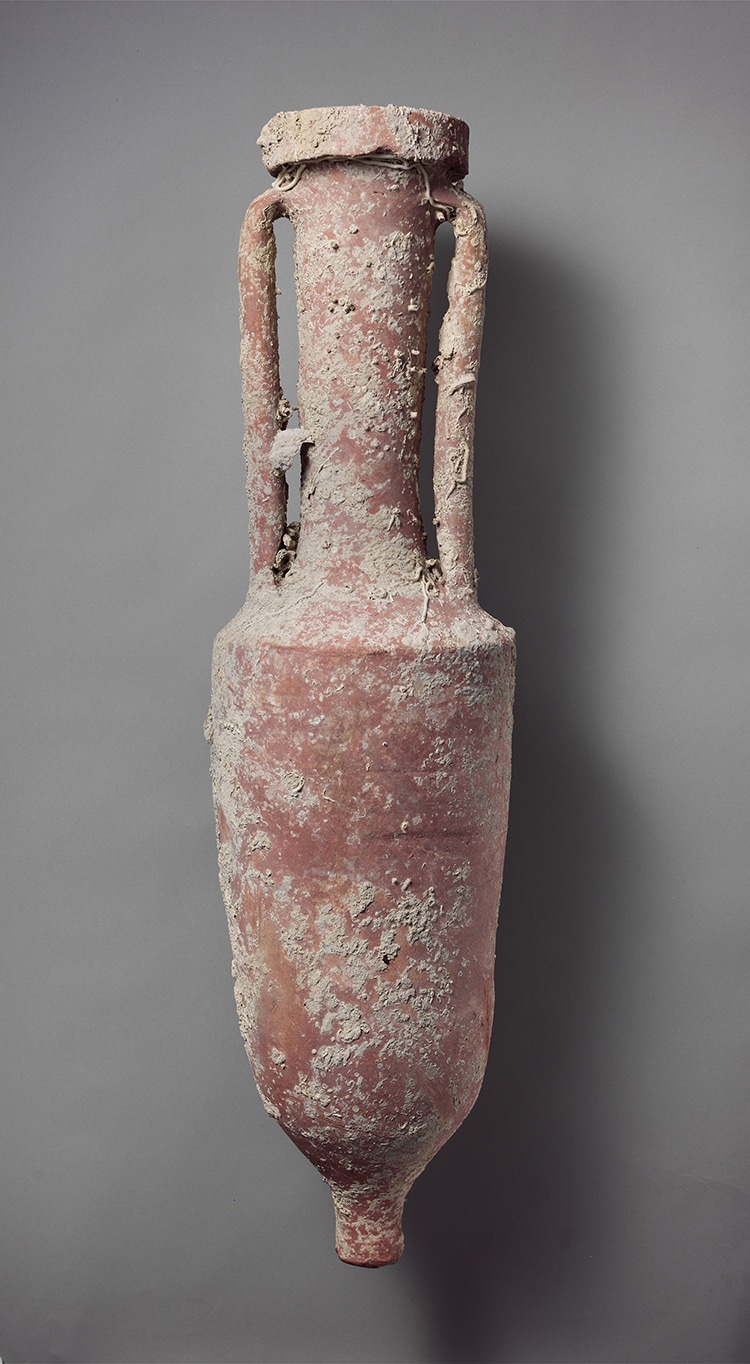
A Roman terracotta wine amphora from 100 BCE. This example comes from a Roman sunken ship which was carrying wine to Gaul. (Photo: The Metropolitan Museum of Art [Public domain])
Wine could be drunk out of handled cups known as scyphus. Unlike today, the ancient Romans usually drank diluted or flavored wine. Roman wine was stronger in taste and alcohol content than wine today, so cutting the alcohol with water was common practice. Although sweet white wines were especially popular, any wine could be flavored with a variety of ingredients. These potential flavors included wormwood, myrtle-berries, figs, roses, asparagus, parsley, radishes, laurels, junipers, cassia, cinnamon, and saffron. For more information on such “artificial wines” for pleasure or medicine, one can read the helpful accounts of Pliny the Elder.
Related Articles:
Archeologist Spends Over 35 Years Building Enormous Scale Model of Ancient Rome
Ancient Roman Mosaic Is Discovered in Pristine Condition Under a Vineyard in Italy
The Good, the Bad, and the Mad: 7 Fascinating Emperors of Ancient Rome
Herculaneum: Pompeii’s Sister City That Survived a Volcanic Eruption in Ancient Rome





























